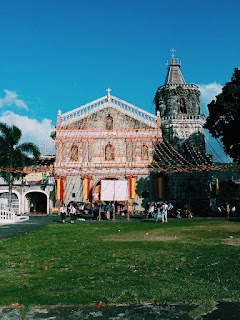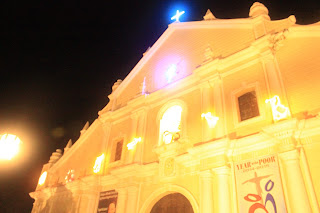Viva! Viva! San Sebastian! This is what we Lumbenos usually shout towards our town patron. This chant of ours is being accompanied by the beating of the drums. The town fiesta of Lumban, is known as one of the festive and happiest celebration in Laguna.
 |
| Viva! Viva! San Sebastian!!! |
Well, fiestas and festivals are still part of travelling let me introduce you to my favorite and most awaited event every January in Lumban.
Before I proceed with the main idea of the 2nd part of my blog regarding Lumban, I will tell you first all the basics that you need to know when it comes to this town.
Let's start with transportation, Lumban, is one bus and jeepney ride away, you will drop off by Sta. Cruz the fare is 117 if coming from LRT/ Buendia, then from Sta. Cruz, ride a jeepney with a signage of Siniloan, or much better if you will ride a jeepney with the signage of Lumban, because Lumban jeepney drivers, have issues with Siniloan jeepney drivers. The jeepney fare costs 13 pesos from the bus terminal.
Let me discuss with you more of the town's history, Lumban follows the Spanish grid housing system, with the church, municipal hall, and the plaza at the center of the town. It is in Lumban, where the first stone church was built outside the walls of Manila, in the year 1572 and the church was completed in the year 1600 with long years of labor and several tragedies, under the order of San Pedro Bautista, the first parish priest. The Lumban church is the first Franciscan building in the province.
The convent of the church still serves as a dormitory for seminarists of the Diocese of San Pablo. It is also here where the Holy Eucharist was first kept and held, and the first Eucharistic procession outside Manila was also held here, and up to now it still remains as a town tradition.
 |
| Lumban church until the year 2012. |
 |
| Lumban church as of now. |
More information about the church, the church structure is somehow different from some of the churches in the province because the belfry is octagonal in shape and it is situated at the right side of the church (if you are facing it). Just like the churches of Paete, Liliw, and Nagcarlan.
The church was first dedicated to Saint Francis of Assisi, but in the year 1800's, our town adopted San Sebastian the Martyr as the patron.
The reason behind why we adopted San Sebastian, stories says, (the story differs, and it may have a different version, this is the version I knew).
 |
| The original image that was found floating in Lumban river. |
The Lumbenos knowing that San Sebastian wants to stay in Lumban, they made him as the town patron, making San Francisco as the secondary patron.
Since, our patron was found floating in the Lumban river, this gave birth to the "paligong poon" and "lupi", well this are two different events in the month of January.
To further discuss, the dates of Lumban town fiesta are January 19, 20 and the last Sunday of January.

January 19, this is what we call, "Bisperas", the "paligong poon" is held during this day, because according to some of the elders, "kailangan munang maligo ni San Sebastian sa ilog, bago siya ilagay sa kanyang andas at bago iprusisyon bukas (January 20).
 |
| 011916- Paligong Poon (c) Abet Rana |
It will stop by a few minutes to say a prayer and will continue the fluvial procession until it dock at Barangay Wawa, and will pass along the street of Rizal until it reach the San Sebastian Church.
 |
| San Sebastian last January 20, 2016. |
The next day January 20, is the town's feast day, the day will start as soon as the church rang its bell at 4 in the morning. Lumban is known, because of the happenings and hospitality of Lumbenos when it comes to handaan. Musical bands perform along the streets and the day ends at a solemn procession at the evening.
At the eve of the Lupi celebration a "Kongzert" is being held near the chapel, this concert is sponsored by Congressman Benjie Agarao, a fellow Lumbeno. The one who sings in the said concert are known Filipino band and singers such as Aegis, Itchyworms and even Yeng herself had done a performance. I wonder who will sing this year.
 |
| The image being brought out of the chapel (January 31, 2016) |
For the last day of the festivity which is the last Sunday of January, this is probably the noisiest, happiest and wettest day in Lumban. It all starts with a mass at the San Sebastian Chapel in Barangay Primera Parang, the mass will end at around 10:30, the original image will then be brought out of the chapel going to the river wherein the devotees carries him in a shoulder borne andas, and together with the devotees they will ride a kaskito.
 |
| 013116- A town fully devoted to San Sebastian |
This time it is not only the original that is being processioned, different images of the patron is joined by the different Lupi organizations. The celebration is very much alike with the Paligong Poon that was held every January 19, but the difference is the route of the procession was changed and different performance acts done by the hired dancers of the different organizations are being presented all throughout the parade. This time the procession pass by the General Luna street then it will also pass through the national highway, and the procession will end at the San Sebastian chapel, the celebration lasts until 4 or 5 in the afternoon.
One of the miracles attributed to our patron, is right after the Lupi Celebration on the last Sunday of January, the temperature isn't that cold anymore, compared to the past days before the Lupi. This was supported by the saying of the elderly, "kapag na paliguan na si Anda Bastian, mawawala na yun lamig dito sa Lumban."
Here are additional photos:
 |
| Ang kaskito na sakay ang orihinal na imahe ni San Sebastian. (January 31, 2016) |
 |
| 013116- Ang pag- ahon ng orihinal na imahe sa daungan sa Barangay Wawa |
 |
| 013116- Ang pag prusisyon sa bayan. Paligong Poon |
All in all, I explained the happenings during the month of January. Probably, this is everything you need to know about this different fiesta of ours, it may not be one of a kind, but our devotion to our patron is very much different and alive.
Additional information:
 |
| Retablo Mayor |
 |
| San Sebastian Martyr, (original image) |
Many suggests that a replica should be made in order for the original image to be preserved, but I think most people don't want a replica being processioned during the festivity.
The vestment that the image is wearing is his "regalia", made out of "pilak" and "pok-pok" (meaning engraved designs). The image is also repainted several times already.
The vestment that the image is wearing is his "regalia", made out of "pilak" and "pok-pok" (meaning engraved designs). The image is also repainted several times already.
I suggest you guys, (those who read my blog) to come visit Lumban this upcoming January 19, 20 and 29, 2017. If you guys will go to Lumban on the 29th, make sure that you are prepared to get wet.
I would also want to add, that public utility jeepneys are being thrown with water especially if you pass by Lumban bridge, I suggest that never travel between the time of celebration. It is a tradition for us to throw water to passing vehicles especially jeepneys. So if people living in the towns from Kalayaan and beyond are going to Sta. Cruz, better not travel on the 29th.
 |
| You have been warned! |
Well, I hope you enjoyed reading this informational/ travel related blog!
 |
| The fiesta program for this year, you are all invited to join us in this celebration! (c) Myeko Paguio |
All photos used are mine except for the credited ones.
I used a waterproof pouch in order to take photos of the last year celebration.
I used a waterproof pouch in order to take photos of the last year celebration.




























